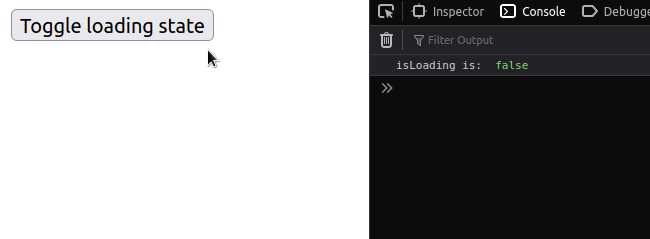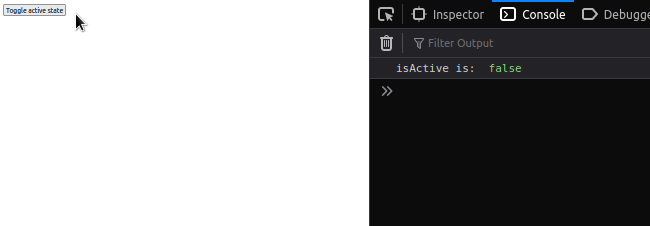How to toggle a Boolean state in React
Last updated: Apr 7, 2024
Reading time·3 min

# Toggle a Boolean state in React
To toggle a boolean state in React:
- Use the
useStatehook to track the state of the boolean. - Pass a function to the
setStatefunction the hook returns. - Toggle the boolean based on the current value.
import {useState} from 'react'; export default function App() { // 👇️ Initialize boolean to false const [isLoading, setIsLoading] = useState(false); const toggleIsLoading = () => { // 👇️ Passed function to setState setIsLoading(current => !current); }; return ( <div> <button onClick={toggleIsLoading}>Toggle loading state</button> {isLoading && <h2>bobbyhadz.com...</h2>} </div> ); }

We passed a function to setIsLoading because the function is guaranteed to be
called with the current (most up-to-date) value for the isLoading boolean.
const toggleIsLoading = () => { // 👇️ passed function to setState setIsLoading(current => !current); };
In the example, we simply toggle the boolean and return the result to update the state.
We used the logical NOT (!) operator to flip the boolean value.
Here are some examples of using the logical NOT operator.
console.log(!true); // 👉️ false console.log(!false); // 👉️ true
If you try to access the isLoading state variable immediately after using the
setIsLoading function to update it, there is no guarantee that you'll get the
current (most up-to-date) value.
# Perform an action when boolean state changes in React
If you need to listen to state changes, add the state variables to the dependencies array of the useEffect hook.
import {useEffect, useState} from 'react'; export default function App() { const [isLoading, setIsLoading] = useState(false); const toggleIsLoading = () => { // 👇️ Passed function to setState setIsLoading(current => !current); }; useEffect(() => { // 👇️ If you need to listen for changes of isLoading boolean console.log('isLoading is: ', isLoading); }, [isLoading]); return ( <div> <button onClick={toggleIsLoading}>Toggle loading state</button> {isLoading && <h2>bobbyhadz.com...</h2>} </div> ); }

We added the isLoading state variable to the hook's dependencies array, so any
time isLoading changes, the logic in our useEffect hook will rerun.
Note that the hook is also invoked when the component mounts.
Here is an example of how to toggle boolean state and make an HTTP request only
when the state is equal to true.
import {useEffect, useState} from 'react'; export default function App() { const [isActive, setIsActive] = useState(false); const [data, setData] = useState({data: []}); const toggleIsActive = () => { setIsActive(isActive => !isActive); }; useEffect(() => { console.log('isActive is: ', isActive); if (isActive) { fetchData(); } else { setData({data: []}); } }, [isActive]); const fetchData = async () => { const response = await fetch('https://reqres.in/api/users', { method: 'GET', headers: {Accept: 'application/json'}, }); const result = await response.json(); console.log('result is: ', JSON.stringify(result, null, 4)); setData(result); }; return ( <div> <button onClick={toggleIsActive}> Toggle active state </button> {isActive && <h2>bobbyhadz.com...</h2>} {data.data.map(person => { return ( <div key={person.id}> <h2>{person.email}</h2> <h2>{person.first_name}</h2> <h2>{person.last_name}</h2> <br /> </div> ); })} </div> ); }

We used the useEffect hook to check if the boolean state is equal to true.
If it is, we fetch data from a remote API, otherwise, we set the data state to
its initial value.
useEffect(() => { console.log('isActive is: ', isActive); if (isActive) { fetchData(); } else { setData({data: []}); } }, [isActive]);
When the state is toggled, the data is shown or hidden depending on if its value
is true or false.
# Listen to changes of a boolean state but skip the first render
If you don't want to run the logic in your useEffect hook on the initial
render, but only when the specific state variable changes, use a ref to return
early on the initial render.
import {useEffect, useState, useRef} from 'react'; export default function App() { const [isLoading, setIsLoading] = useState(false); const toggleIsLoading = () => { setIsLoading(current => !current); }; const isFirstRender = useRef(true); useEffect(() => { if (isFirstRender.current) { isFirstRender.current = false; return; // 👈️ Return early if first render } console.log('isLoading is: ', isLoading); }, [isLoading]); return ( <div> <button onClick={toggleIsLoading}>Toggle loading state</button> {isLoading && <h2>bobbyhadz.com...</h2>} </div> ); }

We used a ref to exit early when the
useEffect hook is run on mount.
useEffect(() => { if (isFirstRender.current) { isFirstRender.current = false; return; // 👈️ Return early if first render } console.log('isLoading is: ', isLoading); }, [isLoading]);
If the ref's value is set to true, we return early from useEffect and set
the ref's value to false.
The next time the useEffect hook runs, the ref's value is set to false and
the remainder of the hook runs.
Use this approach if you want to listen for state changes but need to skip the first render.
I've also written an article on how to render a boolean in JSX.

